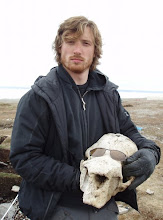I'm going to start today's post by directing you to an article that I have recently read in my History of Archaeological Thought class, which I can simply describe as awesome. It's an older article (published in 1982) but I feel like the message definitely still rings true today and we need to continually keep what is brought up in this article in mind when pursuing our respective Archaeological careers. The message (I think, anyway) that we can take away from it today is that we need to remember that we are both Archaeologists and Anthropologists (in the sense that our goal is to interpret the behaviour of past humans), and that even though we all have our specialties within the field, the only way we can come up with any sort of reasonable interpretation or anything remotely close to a "complete picture"(in quotations because I know we will never have a complete picture of prehistory) is by integrating and taking into consideration data and theory from all of the different sub-disciplines and theoretical approaches. Anyway, read the article, it's a nice and easy one that is very well written. The article is "The Golden Marshalltown: A Parable for the Archeology of the 1980s" by Kent Flannery....who is awesome....by the way.
I've got two other tidbits of cool information for this post. The first is that I've pretty much completed my simulation from my undergraduate Honours Thesis (minus a few small kinks to work out, but I'm nearly there!). And it's pretty sweet, if I do say so myself. I'm modelling the coastal route migration hypothesis for the peopling of the Americas (in NetLogo) to look at what kind of archaeological record is left under different circumstances. Essentially there are 4 scenarios I've created where the environment is either uniform or modeled (with an extremely rich coastal strip and the rest being a randomized environment) and agents who either move randomly or by a randomized form of patch choice modeling (whereby agents stay on their patch until its nearly depleted before moving to a "better" patch). The goal of this model is to look at which circumstances affect the distribution of theoretical archaeological sites in an above sea level to below sea level comparison (as much of the theorized coastal route is now under water as the sea level has risen since the proposed "migration"). Anyway I don't want to get too much more into it in this post because I don't want to bore you all, but if you've got any questions or comments just comment on this post or shoot me an email. Also, I believe the idea is to possibly turn my simulation into a web applet that will be posted on the McGill Computational Archaeology lab website for people to play with at their own free will. So I'll post the link to the website and the web applet if and when this happens!
The second bit of info is that I found out monday that I've been accepted to the Anthropology PhD (Archaeology) program at the University of New Mexico to do my Masters and PhD work. This is pretty damn cool. Another big thank you to my reference letter writers. It's looks like I'm going to have a big decision to make, all the programs look fantastic!
References in this Post:
Kent V. Flannery. 1982. The Golden Marshalltown: A Parable for the Archeology of the 1980s. American Anthropologist, New Series, Vol. 84, No. 2, pp. 265-278.
Subscribe to:
Post Comments (Atom)

3 comments:
Just found your blog and I'm enjoying it. Will read JSTOR article later today.
Thanks Pam! Glad to hear it! The article is pretty great, I'm sure you'll enjoy it.
Cheers, Lars
So, did you already finish your honour thesis? Well, form the sounds of it, you were doing great! But, every once in a while people really need help with thesis project, so it is a good idea to lend a hand to others who need it the most!
Post a Comment